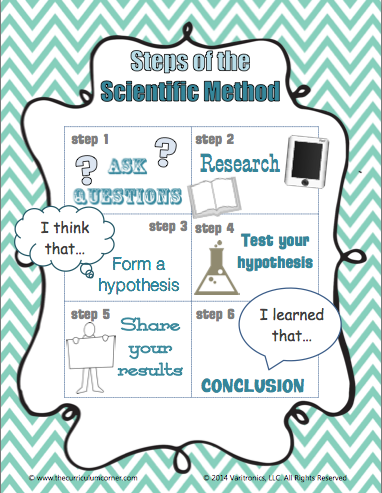We are excited to announce our partnership with two super creative educators from The Curriculum Corner! You can expect to see more blog posts containing free Common Core aligned lesson ideas, teacher resources and templates you can easily print with your VariQuest Perfecta® Series Poster Design System or VariQuest Poster Maker - just be sure you have the latest VariQuest Software!
Lesson: Review of the Scientific Method
Level: Intermediate
Objective: Students will review the steps of the Scientific Method.
Visuals & Materials:
- Anchor Chart – Steps of the Scientific Method
- Science Lab Notes
- Five pennies – severely tarnished or “dirty” - one set for each lab group
- Five small containers for each lab group (each big enough to hold the a penny and a small amount of liquid)
- Tablespoon of each of the following for each lab group: water, dish soap/water mix, glass cleaner, lemon juice and taco sauce (packets from a local fast food restaurant work well)
Click on each image to download the PDF and print to a poster using your VariQuest Software!


Preparation:
- Prepare “Steps of the Scientific Method” anchor chart for mini-lesson.
- Copy the “Science Lab Notes” page for each student in the classroom.
- Assign lab groups, including a materials handler.
Lesson:
-
Pass out “Science Lab Notes” to each student and tell students their assigned groups for the experiment. Have each group find a spot in the room to work and record the names of their group members on their notes.
-
Pass around the sets of pennies and ask students to make some observations within their groups (round, hard, have writing, flat, dirty, etc).
-
Next ask the students if they see a problem with the pennies. Help lead them to the conclusion that they are very dirty and difficult to read.
-
QUESTION - Tell the students that the Scientific Method begins with a question to be answered. What kinds of questions could they come up with about these pennies? Discuss several of the questions, but help lead them to the question, “What is the best way to clean a penny?” or something similar. Have students fill out the Ask Questions section of their notes.
-
RESEARCH – Have groups spend some time discussing what key words /phrases they can think of to search the internet to find an answer to the question and record these on their notes. Give groups ten to fifteen minutes of simple online research, and then tell them to fill out the Research the Problem section of their notes together.
-
FORM A HYPOTHESIS – Ask the class if they have ever heard the word “hypothesis” and discuss answers (if any). If not volunteered by a student, tell them that a hypothesis is a scientific word for an educated guess. Help them to form a hypothesis similar to “We think that _____________ will clean the penny best because ________________.” Have groups fill out the Form a Hypothesis section of their notes together.
-
TEST YOUR HYPOTHESIS – Have each group work together to brainstorm the steps they will use to test their hypothesis using the materials provided. Once they have each recorded these steps in their notes, discuss the Share Your Results section (described below) so that the groups know how to fill it out. Then the assigned materials handler may gather each group’s supplies for the experiment and begin.
-
SHARE YOUR RESULTS – Give students your specific guidelines for how you want them to record their observations. Then discuss how, in this case, the results will simply be shared on the notes page in a sentence format, but that there are other ways to share results too. Tell groups to brainstorm what they think would be the best way to share the results they found in this experiment and write their idea on the notes page in this section.
-
CONCLUSION – At this point the teacher can choose to gather the class and discuss the conclusion as students write on their notes, or for a more self-directed group of students, the teacher can choose to discuss this section beforehand and have students work on it independently or within their groups.
Did you like this lesson? Leave a comment and let us know what topics you would like us to cover in future posts and we will work on delivering free resources to help you prepare for your lessons!



